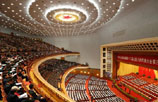Century-old port's new changes
(chinadaily.com.cn) Updated: 2014-07-11 17:43Inner Mongolia's "8337" development strategy proposes to transform the area into an important bridgehead for China to open its northern part as well as a dynamic border economic belt. Manzhouli, a century-old port city, is playing an increasingly important role in realizing the strategic proposal.
Small city, big port
Manzhouli’s customs building was put into use on July 9, 2009. It involved a total investment of 120 million yuan ($19.21 million) and covered an area of 42,000 square meters, including a 34,500-square-meter main building and a 6,000 freight customs clearance building.
With strengthened China-Russia trade, personnel from the two sides have enjoyed increasing exchanges. Manzhouli launched a 24-hour customs clearance mechanism in 2005 to make it easier for bilateral exchanges,” said Zhu Shengmao, director of the Manzhouli land port highway department. “The move has greatly raised customs clearance efficiency.”
Renovation has been underway on a 7,500-square-meter building. A 1,000-square-meter duty-free shop will be established in the customs clearance building, according to an employee with the land port office.
“The renovation will help improve port layout, functions and efficiency,” said Zhu Shengmao.
12-hour freight customs clearance
To the east of the customs clearance building is the area where goods are cleared by customs. There are a great number of large truck and construction machinery vehicles waiting here to be cleared.
Russia has imported a significant number of construction machinery and sedans from China this year. Many sedans entered the Russian market through the port, which has witnessed growing export volume.
“China has been exporting a large number of fresh fruits and vegetables, furniture, home appliances and decoration materials to Russia,” said Zhu.
Individual household becomes foreign trader
The Manzhouli border trade zone has taken advantage of the port’s superior location and resources and has gradually transformed itself into a distinct industrial cluster that integrates imported resource processing, storage logistics, commerce and trade, and tourism. The zone covers an area of 70.1 square kilometers and is home to 100,000 people.
Wide streets connect each and every border trade company in the zone, and vehicles run between the zone and the port, contributing to a land of prosperity.
Li Zheng owns a fruit trade company. He used to peddle fruits at Jalainur district at the end of the last century, and now has expanded his business to Russia after a decade.
“There were only a few kinds of fruits and vegetables being exported to Russia a decade ago. For example, there was only one mandarin orange, but now dozens of varieties are being sent to Russia,” said Li Zheng. “They are very popular with the Russians, so we enjoy very brisk sales,” Li added.
Li’s company exports 30,000 tons of fruits and vegetables to Russia every year, and is expected to see sales double this year thanks to increasing demand from Russia. Most of his goods go to Irkutsk and Chita, and then are distributed to other parts of the world.
“At least one apple sold to Russia out of five is from my company,” Li said with pride.
- Beijing-Tianjin-Hebei rolls out measures to tackle air pollution
- Prosecutors act to curb child abuse
- Shanghai mulls policies for more talent
- Construction on Nansha Islands 'befits China's intl obligations'
- Safety watchdog sends team to probe fatal fire in nursing home
- 175 grave robbers arrested in biggest-ever tomb raid
- China has no overseas military bases: Spokesperson
- Hero pilots died avoiding built-up area
- Canada to seize assets and extradite fugitives: Envoy
- At least 38 killed in nursing home fire in C China






